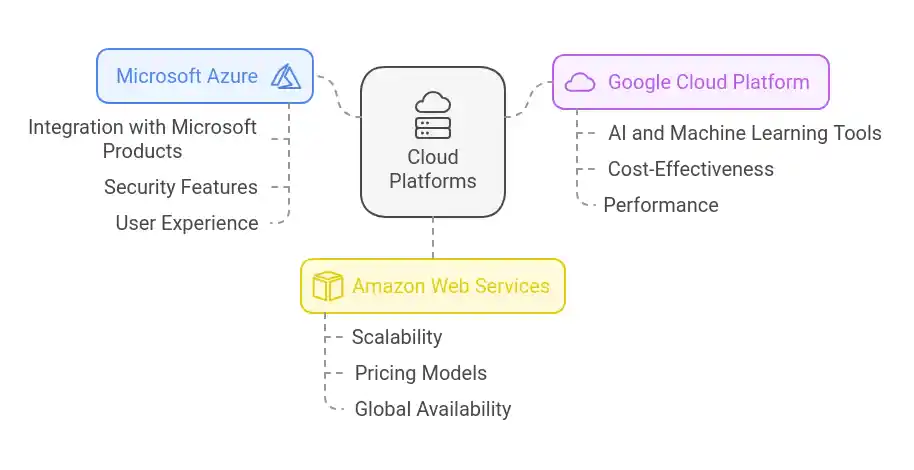Table of Contents
Cloud computing has revolutionized the way businesses operate, enabling them to scale seamlessly and reduce operational costs. Among the top players in the cloud market, Azure VM, Google VM, and Amazon EC2 are the most prominent platforms offering versatile solutions. Each platform has its own unique strengths, pricing structures, and use cases.
In this article, we’ll explore the 7 key differences between these leading cloud platforms, helping you choose the one that aligns best with your business requirements.
1. Overview of the Cloud Platforms
The market is dominated by three giants: Microsoft Azure, Google Cloud Platform, and Amazon Web Services (AWS). Here’s a quick overview:
- Azure VM: A robust service from Microsoft, designed for enterprises requiring hybrid cloud environments and strong integration with Microsoft products.
- Google VM: Part of Google Cloud, this platform is built for modern workloads such as data analytics, AI, and machine learning.
- Amazon EC2: A cornerstone of AWS, Amazon EC2 provides unmatched scalability and a variety of instance types to suit different workloads.
Each of these platforms brings unique features to the table, making it essential to analyze their differences.
2. Pricing Models and Cost-Effectiveness
Pricing is a critical factor when choosing a cloud platform. Here’s how they compare:
- Azure VM: Offers flexible pricing with pay-as-you-go, reserved instances, and hybrid benefits for existing license holders.
- Google VM: Known for its sustained-use discounts, which reduce costs automatically based on usage, making it one of the most cost-effective cloud solutions.
- Amazon EC2: Provides several pricing options, including on-demand, reserved, and spot instances, catering to both predictable and flexible workloads.
Among these platforms, Google VM is often the most affordable for prolonged usage, while Amazon EC2 stands out for dynamic pricing flexibility.
3. Performance and Scalability
Performance and scalability are crucial when evaluating cloud platforms:
- Azure VM: Known for its stability and strong integration with Windows-based environments.
- Google VM: Excels in high-performance computing, particularly for data-intensive applications and machine learning.
- Amazon EC2: One of the most scalable cloud services, capable of handling sudden traffic spikes effortlessly.
For workloads requiring real-time scaling, Amazon EC2 remains the leader among these platforms.
4. Global Availability and Regional Coverage
The global reach of a cloud platform can significantly impact performance and compliance:
- Azure VM: Offers the widest regional coverage, with over 60 global regions.
- Google VM: While fewer in regions, Google’s cloud infrastructure is optimized for low latency and high reliability.
- Amazon EC2: Boasts the largest number of availability zones, ensuring robust failover options.
If global presence is your priority, Azure VM leads the pack among these platforms.

5. Integration and Ecosystem
The ecosystem and integrations offered by a cloud platform play a vital role in its utility:
- Azure VM: Seamlessly integrates with Microsoft products like Office 365 and Active Directory, making it ideal for enterprises invested in the Microsoft ecosystem.
- Google VM: A favorite for developers, thanks to its AI and machine learning tools like TensorFlow.
- Amazon EC2: Part of AWS’s vast ecosystem, EC2 integrates with hundreds of AWS services, offering unparalleled flexibility in building complex applications.
Depending on your existing tech stack, the choice of cloud platform can vary significantly.
6. Security Features and Compliance
Security is non-negotiable when it comes to cloud computing:
- Azure VM: Offers advanced security features, including multi-layered threat detection and compliance with enterprise-grade standards.
- Google VM: Pioneers in security, with end-to-end encryption and a strong focus on zero-trust architecture.
- Amazon EC2: Provides robust tools like Identity and Access Management (IAM) and integrates well with security-focused AWS services.
All three cloud platforms offer robust security, but their implementation varies to suit different use cases.
7. User Experience and Support
The usability and support provided by a cloud platform are essential for both beginners and seasoned users:
- Azure VM: Offers a feature-rich but complex interface, requiring a learning curve for first-time users.
- Google VM: Known for its intuitive interface, making it beginner-friendly while offering advanced capabilities.
- Amazon EC2: Although powerful, its extensive options can overwhelm newcomers, though AWS’s community support compensates for it.
When comparing platforms for user experience, Google VM stands out for ease of use, while Azure VM and Amazon EC2 cater to advanced users.
Conclusion
Choosing the best platform—Azure VM, Google VM, or Amazon EC2—depends on your unique requirements. Azure VM is ideal for hybrid environments and Microsoft-focused businesses. Google VM is the go-to for data-centric workloads and innovation-driven tasks. Meanwhile, Amazon EC2 excels in scalability and flexibility, making it perfect for dynamic applications.
By understanding the key differences in pricing, performance, scalability, and usability, you can confidently select the cloud solution that aligns with your business goals.